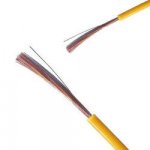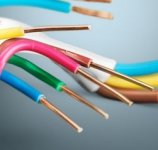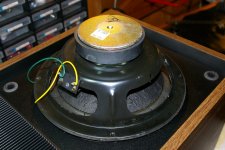Hey Anyone,
I opened up my ancient Snells to find what looks like clear lamp cord supplying the tweeters. Is there an optimal wire to connect the drivers to the crossover?
I opened up my ancient Snells to find what looks like clear lamp cord supplying the tweeters. Is there an optimal wire to connect the drivers to the crossover?
18 ga. lamp cord is fine. You can spend a lot more but you will not likely hear a difference. If you do, there is likely something not right with the other wire.
I would be wary of replacing tweeter wiring where unsoldering and resoldering are involved since overheating can damage fragile tweeter connections.
The current flow to a tweeter is small enough and the connecting lamp cord short enough that resistive power loss will, to all intents and purposes, be negligible.
The current flow to a tweeter is small enough and the connecting lamp cord short enough that resistive power loss will, to all intents and purposes, be negligible.
I'm planning to replace the diaphragms so I have to make new connections anyway. I was intending to use small spade terminals for the final terminations. Or I could heatsink the terminals and solder them. It seems a smaller gauge wire would require less heat?
Yes, use a gauge that is quick to solder. The present gauge is probably about right.It seems a smaller gauge wire would require less heat?
I have seen people soldering monster gauge wire to tweeters - pulls the terminals clean off, if not immediately, then eventually!
I'm planning to replace the diaphragms so I have to make new connections anyway. I was intending to use small spade terminals for the final terminations. Or I could heatsink the terminals and solder them. It seems a smaller gauge wire would require less heat?
I generally use 18ga pure copper hookup wire. I have a small clip, like a tiny steel clothes pin I put on the base of the terminals but you can also use a pair of needle nose pliers as a heat sink. I solder in three steps...1) tin the terminals, 2) while the terminals cool, tin the wire, 3) with a bit of extra solder on my iron hold the wire in place and reflow the solder. It helps to have your iron just a bit too hot so you can get in, get it done and get out quickly.
You need to make make extra certain double sure you're not using copper clad aluminium wire (designation: CCA) ... that stuff is a real bear to solder. The copper softens, the aluminium core expands and is exposed, it corrodes instantly with the heat and air... from there it will actively reject solder.
Only use solid copper wire. (designation: CU or OFC)
18ga CU wire has a resistance of about 6.5 ohms per 1000 feet. A 5 foot run, say from the bottom of the speaker to the tweeter and back, is actually 10 feet of wire. This will contribute about 6.5 / 1000 x 10 == .06 ohms of resistance to the circuit. (CCA wire is about double that)
Wire Data Tables
By this, you mean stranded wire made of copper I assume.Only use solid copper wire.
Attachments
By this, you mean stranded wire made of copper I assume.
Nope ... solid 18ga hookup wire. When I route it away from a cone or run it up a corner, I expect it to stay there.
Attachments
Last edited:
Don't use solid wire, use stranded flex instead.
Solid wire puts a heavy mechanical load on tweeter terminals and in an environment with vibration, such as a speaker, is prone to breaking off over time.
Solid wire puts a heavy mechanical load on tweeter terminals and in an environment with vibration, such as a speaker, is prone to breaking off over time.
Don't use solid wire, use stranded flex instead.
Solid wire puts a heavy mechanical load on tweeter terminals and in an environment with vibration, such as a speaker, is prone to breaking off over time.
Yep, use nice soft wire so that in 6 months you can take your speakers all apart again looking for the buzzing sound that stops when you lay them down... then 6 months later you can try again... More than once I've had strange buzzing sounds in speakers that turned out to be limp wire that sagged over time and found it's way up against a speaker frame or cone.
For that matter, you would be surprised at some of the stuff I've found stuck to magnets... Ever heard the story about the guy who lost his favourite screwdriver?
There is a fatigue risk with solder joints in a high vibration envirionment, and the risk is higher with solid core wire because the wire can exert a bending moment on the solder joint. Solder has terible fatigue properties compared to copper (or just about any other metal).
However, the issues raised by Doug are real, and there is certainly an advantage to using solid wire because it can be routed inside the cabinet and it is very unlikely to move after that. I personally use stranded wire, but I can see the advantages of solid core.
Engineering standard today would require stranded wire in a vibration environment, (such as machines, automotive, and marine), but many standards from decades ago allowed it, with some caveats.
Solid core wire can be used with delicate speaker terminals IF:
1) it is light gage, such as 18 gage.
2) you practice proper strain relief techniques, such as bending a "Z" or "S" shape into the wire near the terminals before attachment, and the wire is properly restrained in the cabinet so that no sustained or vibrational load is applied to the terminal.
If these practices are followed, I would have no problems with solid core.
However, the issues raised by Doug are real, and there is certainly an advantage to using solid wire because it can be routed inside the cabinet and it is very unlikely to move after that. I personally use stranded wire, but I can see the advantages of solid core.
Engineering standard today would require stranded wire in a vibration environment, (such as machines, automotive, and marine), but many standards from decades ago allowed it, with some caveats.
Solid core wire can be used with delicate speaker terminals IF:
1) it is light gage, such as 18 gage.
2) you practice proper strain relief techniques, such as bending a "Z" or "S" shape into the wire near the terminals before attachment, and the wire is properly restrained in the cabinet so that no sustained or vibrational load is applied to the terminal.
If these practices are followed, I would have no problems with solid core.
What on earth are you talking about? I built my first set of speaker 46 years ago and have never had any concern of that sort. Everyone on the planet has the option of routing wires along cabinet walls to the XO via fasteners avoid that sort of nonsense.Yep, use nice soft wire so that in 6 months you can take your speakers all apart again looking for the buzzing sound that stops when you lay them down...
mr2, you can use even thinner stuff like 22 ga. stranded for tweeters in normal hi-fi speakers. It has the advantage of heating quickly when soldering.
There is a fatigue risk with solder joints in a high vibration envirionment, and the risk is higher with solid core wire because the wire can exert a bending moment on the solder joint. Solder has terible fatigue properties compared to copper (or just about any other metal).
It's a speaker, not a paint shaker. The moment of vibaration is likely measured in tenths of a millimetre unless you're working inside a cardboard box.
If these practices are followed, I would have no problems with solid core.
I don't have a photo, unfortunately.
But picture the back of the front baffle behind the drivers. The wire would run up the right side corner of the cabinet, secured on putty (so it can be removed if needed) and then it would come around in a half circle to the back of the drivers. Of course all drivers are mounted with their solder lugs at the bottom. In this arrangement there is enough flex in the wire to allow lifting the driver to get at the solder points. So when installing or servicing you just solder it up and drop the driver into place... the wire flexes into place, retaining it's shape, away from moving surfaces. Over the next few hours it attains a set, relieving internal stresses and forms itself to it's new position, where it will stay virtually forever.
I just don't see the problem...
Of course all drivers are mounted with their solder lugs at the bottom.
Unless you're one of those people who rotate them every now and again 😉
noob question
would solid core sound different to stranded ?? i have read that 2 wire cores twisted sound "brighter" than 2 cores side by side.
would solid core sound different to stranded ?? i have read that 2 wire cores twisted sound "brighter" than 2 cores side by side.
noob question
would solid core sound different to stranded ??
No.
Bose obviously didn't see a problem with using small gauge solid core in these Bose 301 Series II speakers I refoamed - and the connections were wire wrapped, not soldered.I just don't see the problem...
Attachments
Whatever you are doing, Douglas, it seems to be working. I was not trying to be argumentative, I was pointing out to others without your experience how they might use solid core wiring without creating a fatigue problem.
I would have used solid core for the tweeter on my most recent build if I would have had some 20 gage on hand.
I would have used solid core for the tweeter on my most recent build if I would have had some 20 gage on hand.
- Home
- Loudspeakers
- Multi-Way
- Wire?


